Louvre Abu Dhabi
The Louvre Abu Dhabi is an art and civilization museum, located in Abu Dhabi, United Arab Emirates. The museum is located on the Saadiyat Island Cultural District. It is approximately 24,000 square metres (260,000 sq ft) in size, with 8,000 square metres (86,000 sq ft) of galleries,[3] making it the largest art museum in the Arabian peninsula.[4]
اللوفر أبوظبي | |
 East side view of the Louvre Abu Dhabi. | |
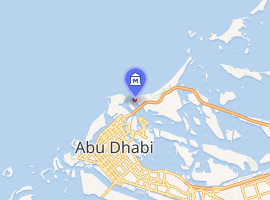
| |
| Established | 8 November 2017 |
|---|---|
| Location | Saadiyat Island, Abu Dhabi |
| Coordinates | 24°32′01″N 54°23′54″E |
| Type | Art Museum |
| Collection size | 35,000 [1] |
| Deputy Director | Hissa Al Dhaheri [2] |
| Director | Manuel Rabaté [2] |
| Architect | Jean Nouvel |
| Owner | Abu Dhabi Department of Culture & Tourism |
| Website | www |
Artworks from around the world are showcased at the museum, with particular focus placed upon bridging the gap between Eastern and Western art.[5]
History
The establishment of the museum was approved by the French Parliament on 9 October 2007. The architect for the building is Jean Nouvel and the engineers are BuroHappold Engineering.[6][7] Jean Nouvel also designed the Institut du Monde Arabe in Paris. The museum is part of a thirty-year agreement between the city of Abu Dhabi and the French government.[4]
The museum was inaugurated on 8 November 2017 by French President Emmanuel Macron and United Arab Emirates Vice President Mohammed bin Rashid Al Maktoum and Crown Prince of Abu Dhabi Mohammed bin Zayed Al Nahyan.[8] US$525 million was paid by Abu Dhabi to be associated with the Louvre name, and an additional US$747 million will be paid in exchange for art loans, special exhibitions and management advice.[9]
The museum is part of a US$27 billion tourist and cultural development for Saadiyat Island, a complex which is planned to include three other museums, including the Guggenheim Abu Dhabi[10] and the Zayed National Museum. According to the government-sponsored website UAE Interact: "The French Museums Agency will operate in collaboration with the Tourism Development and Investment Company (TDIC), which is behind the transformation of Saadiyat Island. It will be chaired by French financier and member of the country's Académie des Beaux-Arts, Marc Ladreit de Lacharrière, publisher of the periodical Revue des Deux Mondes."[11] Bruno Maquart, the former Executive Director of Centre Georges Pompidou, will take the position of Executive Director.[11]
After the deal of the Louvre Abu Dhabi between the French government and the government of Abu Dhabi was announced, former French President Jacques Chirac said:
By choosing the Louvre, the emirate of Abu Dhabi not only sealed a partnership with the world’s most visited and well-known museum, but selected one which, from its very inception, had a vocation to reach out to the world, to the essence of mankind, through the contemplation of works of art.
On November 2019, the street leading to the Louvre Abu Dhabi was named Jacques Chirac Street in celebration of Chirac's efforts to bolster links between France and the UAE during his presidency.[13]
Design

Location
Saadiyat Island's Cultural District plans to house the largest single cluster of world-class cultural assets.[14] In addition to the Louvre Abu Dhabi these are intended to include: Zayed National Museum, to be designed by United Kingdom-based architectural company Foster and Partners under the direction of Lord Norman Foster; the Guggenheim Abu Dhabi contemporary arts museum – expected to be the world's largest Guggenheim; a performing arts centre designed by Zaha Hadid; a maritime museum with concept design by Tadao Ando and a number of arts pavilions.[15]
Architecture
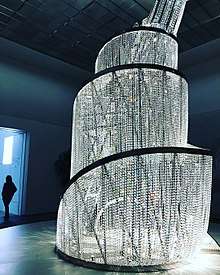
The museum is designed as a "seemingly floating dome structure"; its web-patterned dome allowing the sun to filter through. The overall effect is meant to represent "rays of sunlight passing through date palm fronds in an oasis."[16][17] The total area of the museum will be approximately 24,000 square metres (260,000 sq ft). The permanent collection will occupy 6,000 square metres (65,000 sq ft), and the temporary exhibitions will take place over 2,000 square metres (22,000 sq ft).[9][18]
Engineering
BuroHappold Engineering provided multidisciplinary engineering services across the project, including structural engineering, geotechnical engineering, energy and environmental consultancy, water engineering, facade engineering, lighting design, people movement consultancy, security services and inclusive design. Their structural engineers realised the "floating dome" from 7,850 aluminium stars of varying sizes, which tessellate over eight layers to create a perforated roof structure that allows sunlight through to the spaces below. A team of specialist geotechnical and water engineers designed a watertight basement and tidal pools within the galleries to give the illusion of a "museum in the sea" while protecting artwork, artefacts and visitors from the corrosive marine environment.
Construction
Construction works at Louvre Abu Dhabi officially started on 26 May 2009. Mohammed bin Zayed Al Nahyan, the Crown Prince of Abu Dhabi and the President of France, Nicolas Sarkozy inaugurated an exhibition titled, Talking Art: Louvre Abu Dhabi at the Gallery One of the Emirates Palace hotel which includes 19 works of art bought over the last 18 months for the Louvre Abu Dhabi, as well as loans from the French national museums to mark the beginning of the construction work.
Piling works at the Louvre were to be completed by August 2010, with the piling and enabling works package awarded to the German specialized company (Bauer International FZE).[19] The total of 4536 piles consisted of RC Piles and H-Piles and was completed on 3 August 2010.[20][21][22]
On 29 October 2011, Tourism Development & Investment Company (TDIC.), the project manager owned by the government of Abu Dhabi, announced it would delay establishing the museum. The company gave no new date.[23] According to the UAE newspapers Gulf News and The National, the delay could be explained by a review of the emirate's economic strategy.[24][25]
In January 2012 it was confirmed that the Louvre Abu Dhabi's new opening date would be 2015.[26]
Construction on the main phase of the museum began in early 2013 by a consortium headed by Arabtec, Constructora San José and Oger Abu Dhabi. This stage includes waterproofing and the two basement levels, along with four concrete pillars that will support the 7,000-tonne dome.[27]
Work on the construction of the gallery spaces and initial preparation for the dome began in the fourth quarter of 2013. On 5 December 2013, the first element of the museum's canopy was lifted into place.[28]
On 17 March 2014 TDIC announced the completion of the first permanent gallery structure to mark the first anniversary of the start of construction. At this time, it was claimed that a total of ten million man hours had been worked and 120,538 cubic meters of concrete used.[29]
On 22 September, the final super-sized element in the canopy was fitted in place, marking a significant milestone in the museum's construction phase. In October, The Tourism & Development Investment Company announced that the Louvre Abu Dhabi was more than 50 percent complete.[30]
Visual identity
The three-languages wayfinding system for the Louvre Abu Dhabi was designed by Philippe Apeloig, and is implemented in both Arabic and Roman script. Frutiger LT typeface has been chosen for the Roman texts for its perfect readability for signage; while Lebanese typographer Kristyan Sarkis created an Arabic bespoke typeface, the LAD Arabic, based on the classic Naskh style and his Colvert Arabic font.
The design of the pictograms was inspired by the museum’s architecture, and particularly by the abstract shapes created by the rain of light filtering through the gigantic dome's mashrabiyas. Each pictogram is a combination of several of these shapes, creating silhouettes and objects.
Collection
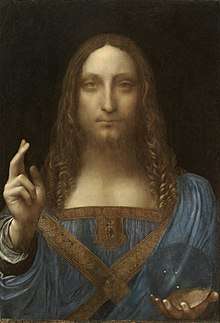
Questions have been raised as to the nature of the artworks to be displayed at the museum. However, according to The National: "the type and nature of the exhibits planned for the Louvre Abu Dhabi have been affected to no extent by the fact the new museum would be in a Muslim country, said Mr. Loyrette."[32]
Subjects and themes have been freely discussed with our partners in Abu Dhabi and no request to avoid such subjects has been made. The exhibition policy will be set up regarding excellence and high-standard quality. As a new museum we hope the Louvre Abu Dhabi will be part of the international community.
— Henri Loyrette[32]
It has been noted that the museum will showcase work from multiple French museums, including the Louvre, the Centre Georges Pompidou, the Musée d'Orsay and Palace of Versailles. However, Renaud Donnedieu de Vabres, the French Minister of Culture, stated at the announcement that the Paris Louvre "would not sell any of its 35,000-piece collection currently on display".
It will not be dedicated to occidental art but will show all kinds of artistic creations. It will set up a dialogue between west and east, between north and south. As such, art from the Middle East will be shown within the Louvre Abu Dhabi.
— Henri Loyrette[32]
In 2012, the Louvre Abu Dhabi started collecting photography, making its first acquisitions in the field, including works by Joseph-Philibert Girault de Prangey, Roger Fenton and George Wilson Bridges. The museum also acquired a sculpture of a Bactrian princess dating from the third millennium BC, a pavement and fountain set from the early Ottoman period, as well as the paintings Breton Boys Wrestling (1888) by Paul Gauguin and The Subjugated Reader (1928) by René Magritte.[33]
Further details of the museum's collection on opening were revealed in October 2014, with a number of important works to be loaned under the agreement with Agence France-Muséums and the Musée du Louvre, including Leonardo Da Vinci's La Belle Ferronniere[34] and works by Henri Matisse, a self-portrait by Vincent Van Gogh, Jacques-Louis David's Napoleon Crossing the Alps and Claude Monet's Gare Saint-Lazare.[35]
@LouvreAbuDhabi tweeted[36] 8 December 2017 that the Louvre Abu Dhabi is looking forward to displaying the Salvator Mundi by Leonardo Da Vinci. The work was acquired, at a record price for a painting, by the Department of Culture & Tourism of Abu Dhabi for the museum. No date was set for the display of this work but in September 2018, the unveiling was indefinitely postponed[37] and a January 2019 news report indicated that "no one knows where it is, and there are grave concerns for its physical safety".[38]
Exhibitions
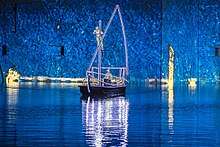
The Louvre Abu Dhabi first started sharing its collection with the public through an exhibition entitled "Talking Art: Louvre Abu Dhabi," which opened in May 2009. The exhibition presented the first 19 acquisitions for the institution, including a Mamluk holy Quran from the 14th century, a 5th-century Fibula from Domagnano, a Virgin and Child by Bellini, and Mondrian’s Composition with blue, red, yellow and black from 1922.[39]
A second exhibition, "Birth of a Museum", opened at the exhibition space Manarat Al Saadiyat in May 2013, ending in August that year. The first large-scale preview of the collection, it featured 130 works acquired by the government of Abu Dhabi for the permanent collection. They included a never-before-seen work by Picasso, a Bronze Age terracotta statue from Cyprus, along with artifacts from Greece, Turkey, Japan and Syria.[40]
In May 2014, the Birth of a Museum exhibition, featuring works shown in Abu Dhabi and a number of new acquisitions opened at the Louvre in Paris. A number of new works were presented, including Chirisei Kyubiki by the Japanese artist Kazuo Shiraga and painted in 1960.[41]
Other programmes
The Louvre Abu Dhabi has also been working with the Paris Sorbonne University Abu Dhabi to set up a master’s program for museum professionals to train them and help them respond to local needs.[39]
Management
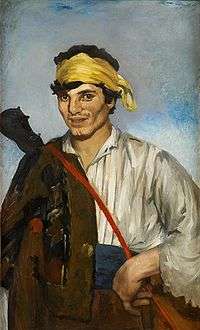
Contract
Louvre Abu Dhabi is an entirely separate museum from the Louvre in Paris, although the two are linked by a thirty-year branding and training agreement and the Paris Louvre is one of the 12 shareholders in Agence France-Muséums.[39] The thirty-year agreement, signed by French Minister of Culture Renaud Donnedieu de Vabres and Sheik Sultan bin Tahnoon Al Nahyan, will prompt the construction of a Louvre museum on Saadiyat Island, near central Abu Dhabi, in exchange for US$1.3 billion.[18] The contract prohibits the creation of any similar operation with the name of the Louvre in any of the other emirates of the UAE, Saudi Arabia, Kuwait, Oman, Bahrain, Qatar, Egypt, Jordan, Syria, Lebanon, Iran, or Iraq.[42] French President Jacques Chirac praised the museum deal with Abu Dhabi, saying it reflects "a certain idea of the world" in which each party to the accord, "proud of its roots and of its identity, is conscious of the equal dignity of all cultures."[43][44]
Cost
US$525 million was paid by Abu Dhabi to be associated with the Louvre name, and an additional $747 million in exchange for art loans, special exhibitions and management advice.[9] Arabtec is leading a consortium that is building the museum under a $653 million contract awarded early in 2013.
Cost estimates
US$525 million was paid by the city of Abu Dhabi for the use of the Louvre brand name, with US$195 million payable within a month.[45] In addition to this, US$247 million will be paid for the loan of artworks from the Louvre over a ten-year period, with a total of between two hundred and three hundred artworks expected. The Parisian Louvre will also be providing management advice to its Middle Eastern counterpart, at a cost of US$214.5 million. An additional US$253.5 million will be paid for various special art exhibitions. A total of four exhibitions will be hosted per year over a period of fifteen years.[9] The city of Abu Dhabi will also make a direct donation of US$32.5 million to the Louvre to refurbish a wing of the Pavillon de Flore for the display of international art.
Controversies
Motivations for the deal
The museum has sparked opposition to the expansion of the Louvre name in both artistic and academic circles in France. The opposition that has surfaced in France is led by art historian Didier Rykner, who is considered one of the most outspoken critics of the French–Emirati museum deal.[46] An online petition against the deal, signed by 4,650 curators, archaeologists and art historians, has insisted that French museums are not for sale.[47][48] Klaus-Dieter Lehmann, the president of the Prussian Cultural Heritage Foundation, characterized the Louvre as behaving "like a corporation with a clearly-defined strategy: profit maximization."[18]
According to the New York Times, Henri Loyrette, the president and director of the Louvre, responded to the criticism of the museum’s policy of establishing footholds abroad, arguing that the Louvre cannot ignore the "internationalization" of museums.[49] French minister of culture, Renaud Donnedieu de Vabres, vindicated the French government decision to expand the Louvre to Abu Dhabi explaining that it helps to enhance the image of France abroad as well as help invest in French culture through revenues made from the deal.[50] The United Arab Emirates president Sheikh Khalifa bin Zayed Al Nahyan stated that the museum is a milestone in international cooperation and contributes to a longstanding friendly ties between France and the United Arab Emirates.[16]
Treatment of construction workers
Human Rights Watch reported issues during construction of Louvre Abu Dhabi including the confiscation of workers passports resulting in forced labour conditions.[51] High "recruitment loans" paid by migrant workers to construction companies still had not been repaid as of 2019, according to government-paid monitors. 86% of these fees were over $2000.[52] The Human Rights Watch report welcomed improvements in the law made by the UAE since their previous report in 2009 such as the introduction of minimum standards for workers accommodation. However, they added "the true test lies in the impact of these changes on workers" and suggested that if the abusive recruitment fees were not reimbursed by construction companies or the UAE government, the responsibility to repay them lies with the foreign sponsors who gave their names to the project such as the Louvre.
Amid these reports, Jean Nouvel, the architect of Louvre Abu Dhabi defended the treatment of the construction workers, claiming that the conditions of construction workers were better than some European countries.[53]
See also
- Cultural policy in Abu Dhabi
References
- "France to Open New Louvre in Abu Dhabi". washingtonpost.com. Retrieved 19 December 2017.
- "Louvre Abu Dhabi Director and Deputy Director appointed". Retrieved 19 December 2017.
- "The Louvre Abu Dhabi – Louvre Museum – Paris". 6 September 2017.
- Heathcote, Edwin (10 November 2017). "The Gulf's blockbuster new Louvre arrives — and it's utterly original". Financial Times. Retrieved 12 November 2017.
- "Vincent Van Gogh, Andy Warhol, Claude Monet and Henri Matisse in Louvre Abu Dhabi". Glammonitor. 21 October 2014. Archived from the original on 23 October 2014. Retrieved 21 October 2014.
- "Le "Louvre Abu Dhabi" verra bien le jour". Le Figaro (in French). 9 October 2007.
- Robinson, Victoria (7 January 2008). "Abu Dhabi and Paris sign museam deal". MEED. Retrieved 12 September 2008.
- Langton, James (8 November 2017). "Emmanuel Macron and UAE leaders formally open Louvre Abu Dhabi". The National.
- "Riding, Alan". The New York Times. 7 March 2007. Retrieved 9 September 2008.
- "Feu vert du parlement français au futur musée "Louvre Abou Dhabi"". AFP. Archived from the original on 9 June 2007.
- "French cultural agency to steer work on Louvre Abu Dhabi". UAE Interact. 13 August 2007. Retrieved 17 September 2008.
- "Louvre Abu Dhabi to be created within the Saadiyat Island Cultural District". Mena Report. 8 September 2008. Archived from the original on 15 April 2008. Retrieved 9 September 2008.
- Dajani, Haneen (11 November 2019). "Street named in honour of Jacques Chirac at Louvre Abu Dhabi ceremony". The National.
- "French Culture Minister heads delegation to UAE capital to seal Louvre Abu Dhabi operating framework". AME Info. 7 January 2008. Archived from the original on 30 October 2008. Retrieved 16 September 2008.
- "Louvre Abu Dhabi". Nafas Art Magazine. 2007. Archived from the original on 6 March 2011. Retrieved 26 September 2008.
- "Louvre Abu Dhabi – Art Gallery and Museum". Design Build Network. 2008. Retrieved 8 September 2008..
- "Louvre, Abu Dhabi". Wallpaper. 7 May 2007. Archived from the original on 11 February 2009. Retrieved 16 September 2008.
- "Art in the Desert: 'Louvre Abu Dhabi' Gets Green Light". Spiegel Online. 3 July 2007. Archived from the original on 12 October 2012. Retrieved 8 September 2008.
- "Bauer International FZE". www.baueruae.ae.
- Eman Mohammed (26 May 2009). "Construction of historic Louvre Abu Dhabi museum starts". Gulf News. Archived from the original on 29 May 2009. Retrieved 1 June 2009.
- Vogel, Carol (26 May 2009). "Abu Dhabi Gets a Sampler of World Art". New York Times. Retrieved 1 June 2009.
- "Louvre Abu Dhabi gets green light". Gulf News. 10 October 2007. Archived from the original on 13 September 2008. Retrieved 8 September 2008.
- "Statement by T.D.I.C., October, 29, 2011". Archived from the original on 9 November 2011.
- Showcase projects yield to more urgent needs, Gulf News, 10 November 2011
- "TDIC outlines new roll-out of museums". The National. Archived from the original on 31 October 2011.
- Sara Hamdan (26 September 2012). "After a Sputtering Start, the Louvre Abu Dhabi Project Gathers Pace". nytimes. The New York Times Company. Retrieved 10 January 2013.
- James Langton (11 October 2013). "A modern marvel in the making". thenational. Abu Dhabi Media. Archived from the original on 14 October 2013. Retrieved 24 May 2013.
- "Louvre Abu Dhabi chalks up another towering achievement". The National.
- "From a patch of sand to the outline of a masterpiece". The National.
- "The story of the final piece of the Louvre Abu Dhabi". The National.
- "A Leonardo Made a $450 Million Splash. Now There's No Sign of It". New York Times. 30 March 2019. Retrieved 16 July 2019.
- Bardsley, Daniel (19 August 2008). "Abu Dhabi's Louvre to get Middle East art". The National. Archived from the original on 11 February 2009. Retrieved 8 September 2008.
- Gareth Harris (14 September 2012), Louvre Abu Dhabi acquires its first photographic works Archived 21 September 2012 at the Wayback Machine The Art Newspaper.
- Nick Leech. "Louvre Abu Dhabi to be first museum in the Middle East to show a Leonardo Da Vinci painting". thenational.ae. Retrieved 9 November 2015.
- Anna Seaman. "Van Gogh, Manet, Monet and Matisse among artworks to be lent to Louvre Abu Dhabi". thenational.ae. Retrieved 9 November 2015.
- "Louvre Abu Dhabi is looking forward to displaying the Salvator Mundi by Leonardo Da Vinci". @LouvreAbuDhabi. 8 December 2017.
- "Louvre Abu Dhabi postpones display of Leonardo's Salvator Mundi". The Guardian. 8 January 2019. Retrieved 12 January 2019.
Delayed unveiling of world’s most expensive painting adds to mystery shrouding its acquisition and authenticity
- "Where in the world is Salvator Mundi, the most expensive painting ever sold?". National Post. 8 January 2019. Retrieved 12 January 2019.
- Sara Amdan (26 September 2012), After a Sputtering Start, the Louvre Abu Dhabi Project Gathers Pace New York Times.
- Emily Cleland. "Sneak peek at treasures of Louvre Abu Dhabi". thenational.ae. Archived from the original on 22 January 2016. Retrieved 9 November 2015.
- Nick Leech. "Abu Dhabi's Birth of a Museum exhibition opens at Louvre in Paris". thenational.ae. Retrieved 9 November 2015.
- "Louvre Abu Dhabi's exclusive deal". de51gn.com. 30 July 2008. Archived from the original on 6 January 2009. Retrieved 9 September 2008.
- Heliot, Armelle (15 October 2007). "Le Louvre Abu Dhabi sous une coupole aérienne". Le Figaro (in French). Retrieved 16 September 2008.
- Gomez, Edward (2008). "A Louvre for Abu Dhabi? It's a done deal". SFGate.com. Retrieved 16 September 2008.
- Dilanchian, Noric (13 March 2007). "Louvre Abu Dhabi". Dilanchian Lawyers and Consultants. Archived from the original on 29 July 2008. Retrieved 8 September 2008.
- Farhat, Maymanah (27 March 2007). "The Louvre Abu Dhabi, Exploitation and the Politics of the Museum Industry". ZNet. Archived from the original on 2 December 2008. Retrieved 8 September 2008.
- Astier, Henri (7 March 2007). "Gulf Louvre deal riles French art world". BBC News. Retrieved 8 September 2008.
- Krane, Jim (6 March 2007). "France's Louvre branching to Abu Dhabi". Boston.com. Retrieved 17 September 2008.
- Van Gelder, Lawrence (9 January 2007). "Arts, Briefly". New York Times. Retrieved 8 September 2008.
- Riding, Alan (13 January 2007). "Abu Dhabi Is to Gain a Louvre of Its Own". The New York Times.
- Avenue, Human Rights Watch | 350 Fifth; York, 34th Floor | New; t 1.212.290.4700, NY 10118-3299 USA | (21 March 2012). "The Island of Happiness Revisited | A Progress Report on Institutional Commitments to Address Abuses of Migrant Workers on Abu Dhabi's Saadiyat Island". Human Rights Watch. Retrieved 10 November 2019.
- "The Louvre Abu Dhabi opens amid controversy over labour conditions". Middle East Eye. Retrieved 10 November 2019.
- "Architect defends treatment of workers at Louvre Abu Dhabi". The Guardian. 24 September 2017.
Further reading
- Koek, Marjolein (6 July 2007). "The 'Desert Louvre' – a change in museum policy?". The Business of Art. University of Sydney. Archived from the original on 22 September 2018. Retrieved 16 September 2008.
- Milliard, Coline (November 8, 2017). "After Years of Controversy, the Louvre Abu Dhabi's Grand Ambitions Fall Short". Artsy. Retrieved November 12, 2017.
External links
| Wikimedia Commons has media related to Louvre Abu Dhabi. |